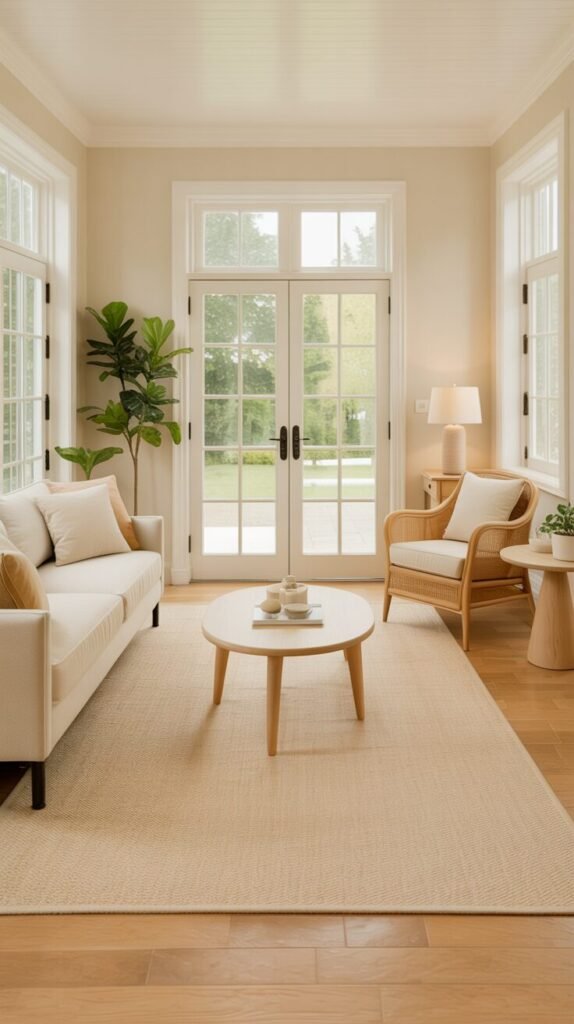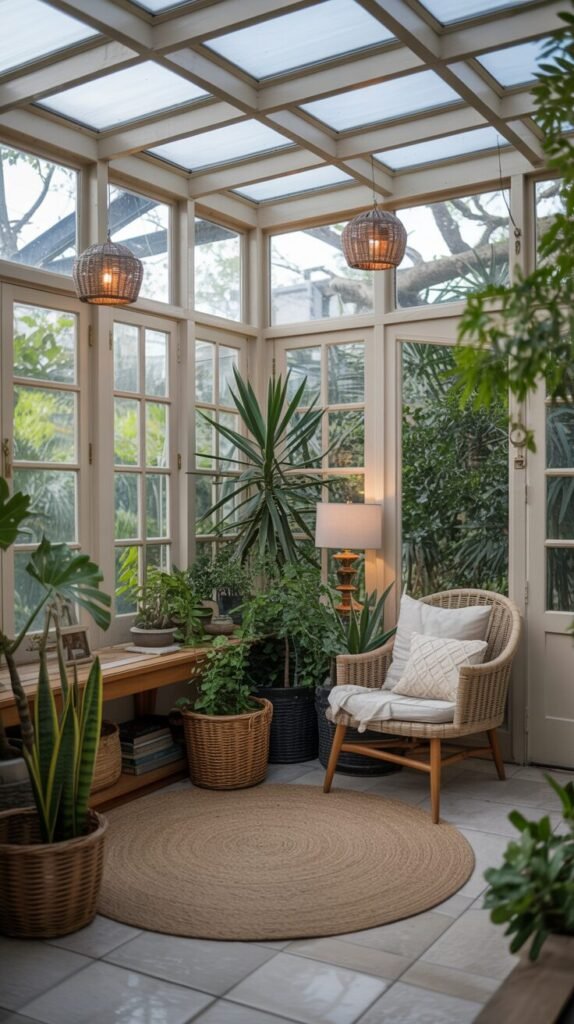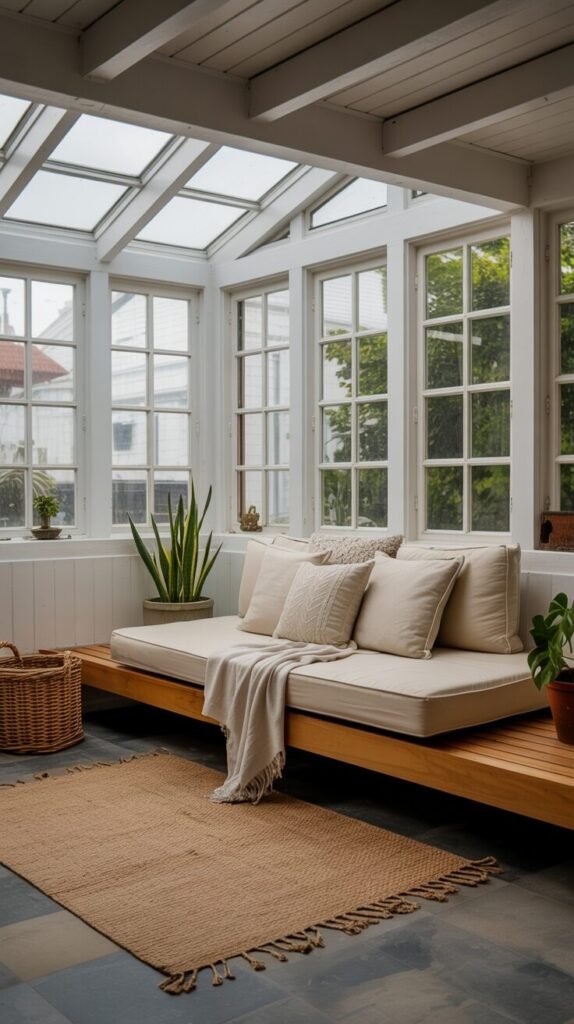How to Style a Sunroom That Feels Effortlessly Sophisticated

There’s something undeniably magnetic about a well-designed sunroom. It’s where architecture and atmosphere meet—bathed in natural light, yet grounded in comfort. But true sophistication in a sunroom doesn’t come from filling it with pretty things.
It comes from intention. From how light moves, how space breathes, and how materials speak to one another. Designing a sunroom that feels effortlessly elegant starts here—with a deeper look into the principles behind that feeling.
The Interior Principles That Give a Sunroom Soul
A beautiful sunroom isn’t just about how it looks—it’s about how it feels. When design principles are applied with subtlety and purpose, the room begins to breathe. Light flows better, objects feel intentional, and the entire space gains rhythm. These are the quiet foundations that give a sunroom its soul, far beyond the visual.
Why Leaving Space Can Be the Most Powerful Design Choice
One of the most overlooked yet transformative principles in interior design—especially in sunrooms—is the celebration of negative space. When you look at the image above, what’s most striking isn’t what fills the room, but rather what doesn’t. The generous breathing room between the furniture pieces isn’t accidental; it’s deeply intentional.
Negative space, in design language, is the area that’s left open around objects. It’s not “empty”—it’s purposeful silence. In sunroom styling, this silence allows natural light to travel, visual flow to feel seamless, and each object to have presence without shouting.
Technically speaking, it’s about visual balance and spatial hierarchy. Notice how the seating, table, and side elements are well-proportioned but spaced apart. There’s room for movement, light play, and visual rest—elements that give a room its understated elegance.
Leaving space also enhances the psychology of the room. It creates calm, encourages pause, and reinforces the idea that this sunroom isn’t just beautiful—it’s livable. When we resist the urge to overfill, we allow light, texture, and form to breathe.
Style tip: When styling a sophisticated sunroom, ask yourself: “Can this space breathe?” If every corner feels occupied, try removing just one item—and see how the room rewards you.
How to Curate Greenery That Feels Botanical—Not Just Decorative
There’s a big difference between placing a few plants in a room and truly curating a botanical moment. In a sophisticated sunroom, greenery should feel intentional, not like a filler. The space in the image above showcases this beautifully—notice the balance in height, texture, and color. Tall, structural plants like dracaena anchor the corner, while softer varieties like ferns add fullness and contrast.
This technique leans on the principle of biophilic composition—arranging plants to mimic how they appear in nature: layered, varied, and rhythmic. Mixing upright, trailing, and bushy silhouettes helps the eye move organically through the room.
To take it further, use pots that complement the rest of the decor—like woven baskets or terracotta. These natural materials create harmony between the greenery and the furnishings.
Style tip: Group plants in threes, varying scale and shape. The visual result feels far more curated—and deeply calming.
Designing for the Light: Let Your Sunroom Shift Beautifully With the Day
A well-designed sunroom isn’t static—it transforms gracefully as the light changes. Morning sunlight is crisp and cool, while golden hour introduces softness and warmth. The key is to design not just for one moment of beauty, but for a continuous conversation with the sun.
In the image above, you can see how the natural light pours through tall windows, casting layered shadows and warming every neutral surface. The placement of the sofa directly opposite the window invites slow mornings, while the warm-toned rattan chair and lamp glow beautifully in the afternoon. This setup is not accidental—it’s rooted in temporal spatial planning, where the use and mood of a space shift depending on the time of day.
Material choice plays a huge role here. Soft linen upholstery, lightly stained wood, and earthy ceramics subtly react to changing light, bringing depth and dimension to the room without the need for bold color.
Furniture That Feels Airy, Functional, and Just the Right Kind of Elegant
Once the light is right, the next layer of design magic comes from the furniture you choose to live within it. In a sunroom, bulkiness is the enemy. You want pieces that breathe with the space, not overpower it. Think fluid silhouettes, thoughtful materials, and just enough presence to feel curated—but never overdone.
Every element should serve a purpose—whether it’s lounging, reading, or simply inviting you to slow down. In the next few sections, I’ll walk you through a few furniture choices that strike the perfect balance between form, function, and that effortless elegance we’re all chasing.
Why Low Lounge Chairs with Sculptural Lines Work So Well in a Sunroom
Low lounge chairs might seem like a subtle design choice, but in a sunroom, they can completely shift the mood—and function—of the space. The chairs in this image are a perfect example: lightweight in form, sculptural in shape, and grounded just enough to feel intimate without dominating the room.
From an interior design perspective, these chairs align with the principle of visual elevation. By keeping furniture low-profile, you naturally draw the eye upward—to the light, the windows, and the view outside. They also support spatial breathability, allowing negative space around and beneath them to remain uninterrupted.
The sculptural lines add a layer of artistry. Their curved slats and angled legs speak to mid-century influences, but feel contemporary and clean. Pairing them with a round jute rug softens the geometry and grounds the setting with a textural contrast.
Functionally, they’re relaxed, conversation-friendly, and ideal for lounging with a book while soaking up the sun.
Style tip: When choosing lounge chairs for your sunroom, look for ones that sit lower than your sofa and have a light, open-frame base—this helps keep the room feeling airy and elegant.
How an Organic-Shaped Side Table Can Quietly Anchor a Space
In a room that breathes light and softness, even the smallest furniture pieces can become emotional anchors. Take the table in this image—its fluid, organic form is sculptural without being loud, artistic yet approachable. It doesn’t just sit between two chairs; it grounds them, gently breaking the symmetry and drawing your eye inward.
This kind of piece aligns with the principle of tactile presence in design. When sharp angles and hard lines dominate a room (think window frames, sofa arms, tile edges), introducing a rounded, asymmetric form creates contrast and visual relief. It’s a soft interruption in a structured space.
The wood grain and hand-carved curves in this table mimic natural elements, echoing the outdoor garden just beyond the glass. It blurs the line between furniture and art, while still offering a place to rest a coffee or a plant.
Built-In Benches: The Underestimated Secret to Comfort and Character
There’s something inherently grounding about built-in seating, especially in a sunroom. It’s not just furniture—it’s architecture. The bench in this space doesn’t feel like it was added; it feels like it belongs here. And that’s exactly the point.
Built-in benches offer a seamless way to define the perimeter of a sunroom while maximizing usable space. Their low profile keeps the sightline clean, while their custom fit allows for layered cushions, oversized pillows, and all the comfort of a sofa—without the bulk. But more than practicality, they carry a quiet charm: they evoke memories of garden rooms, old villas, and cozy reading nooks tucked into glass corners.
From a design standpoint, they also anchor the room spatially. The U-shaped bench pictured here encourages conversation, invites lounging, and draws the eye out toward the lush garden beyond. Paired with aged wood and botanical prints, the entire setup radiates casual elegance.
Style tip: Don’t worry about perfection. A slightly weathered bench or mismatched cushions only adds to the character. Built-ins aren’t meant to be pristine—they’re meant to feel lived-in and loved.
The Floating Daybed That Makes Any Sunroom Feel Like a Boutique Escape
There’s something instantly luxurious about a well-placed daybed—especially when it appears to float effortlessly in a room full of light. In this sunroom, the design takes on a spa-like quality: low, streamlined, and surrounded by calm neutrals that whisper relaxation, not shout for attention.
The magic lies in the construction. The open-base platform gives the daybed a floating effect, visually lifting it from the floor and creating a sense of lightness that resonates with the airiness of the space. This aligns with the principle of optical weightlessness—a design strategy that makes furniture feel like part of the architecture rather than separate from it.
Functionally, it’s incredibly versatile. This daybed invites everything from solo reading to afternoon naps or quiet conversations with the windows cracked open. And the layering of knit pillows, soft throws, and textured weaves adds depth without bulk—just enough softness to keep it warm and welcoming.
Style tip: If you want your daybed to feel boutique-level elegant, avoid over-accessorizing. Stick to tonal layers in different textures and keep the base clean and minimal. Let the light—and the silhouette—do the talking.
The Subtle Power of Color: Tones That Shift the Mood Without Saying a Word
After the furniture is placed and the light dances just right, color becomes the emotional thread that ties everything together. In a sunroom, color isn’t just decorative—it’s deeply atmospheric. The right shade can elevate the quietest corner, soften harsh light, or wrap the room in warmth without a single spoken word.
It’s not about painting the walls bold; it’s about choosing tones that feel like sunlight, softness, and stillness. Let’s explore how color psychology, when used with intention, can completely change how your sunroom is felt—even before a word is said or a seat is taken.
Why Cream Is Warmer, Softer, and So Much Smarter Than White
White may be classic, but in a sunroom, it often misses the mark. It can feel stark, clinical—even cold. Cream, on the other hand, offers all the clarity of white but with added warmth and emotional depth. In the space above, notice how the cream tones on the upholstery, walls, and ceiling catch the light—they don’t just reflect it; they soften it.
Cream works so beautifully in sunrooms because it responds well to natural shifts in daylight. Morning sun gives it a gentle glow, while golden hour turns it almost buttery. This tonal flexibility is why designers consider cream a dynamic neutral—it enhances the room’s mood without dominating it.
Psychologically, cream feels more welcoming than white. It has a softness that encourages relaxation, making it ideal for transitional spaces like sunrooms that serve both function and escape.
Bring the Outside In With Soft Greens That Calm the Nervous System
Few colors have the ability to instantly calm a space quite like soft green. In this sunroom, gentle sage walls and leafy accents wrap the room in a layer of peace that feels both natural and intentional. It’s more than just a color choice—it’s an emotional strategy.
Soft green tones tap into the principles of biophilic design—our innate psychological connection to nature. When used in interiors, especially sunlit spaces, these hues help regulate the nervous system by reducing visual stress.
Design-wise, the muted green provides a subtle contrast to crisp white upholstery and natural rattan textures. It enhances the greenery placed throughout the space, allowing potted plants and botanical prints to feel integrated, not separate.
What’s powerful here is how green functions as both background and mood-setter. It doesn’t dominate; it gently harmonizes.
Style tip: Choose greens with gray or muted undertones—like sage, eucalyptus, or celadon—for a calming effect. They pair beautifully with natural textures like linen, wood, and cane, and they evolve beautifully throughout the day as the light shifts.
Desaturated Colors: A Shortcut to Instant Mental Clarity
When life feels noisy, your home should whisper. That’s exactly what desaturated colors do—they create a visual pause. In the image above, the muted tones of the window frames, natural rug, and soft cream upholstery speak in a language of calm. Nothing screams for attention, and that’s the point.
Desaturated colors—think stone, greige, soft putty, linen white—help reduce visual stimulation, which is directly tied to mental clarity. In design psychology, these tones are known to lower cognitive load. They offer a backdrop that soothes the nervous system and encourages your mind to settle.
The palette also enhances light without bouncing it aggressively. The sunlight in this room feels filtered, soft, and serene, thanks to how it interacts with these dusty neutrals. Even the greenery outside reads more vibrant when placed against a quiet, tonal interior.
Style tip: Layer different shades of the same desaturated family—warm greys, muted beiges, faded taupes—and break it up with texture instead of color. Add one living element, like a single orchid or olive branch, to complete the mental reset.
Where Light Meets Stillness: Your Sunroom, Reimagined
A truly sophisticated sunroom isn’t just about pretty furniture or curated plants—it’s about what the space feels like. It’s the softness of filtered light, the ease of movement, and the quiet intentionality behind every piece you choose. From sculptural lounge chairs to calming color palettes, every element is part of a larger rhythm—one that honors stillness, presence, and light.
Whether you’re designing from scratch or refining what you already have, remember this: your sunroom isn’t a showpiece. It’s a retreat. And when designed with care, it becomes your favorite kind of quiet.










